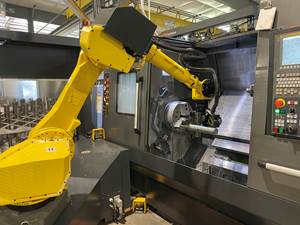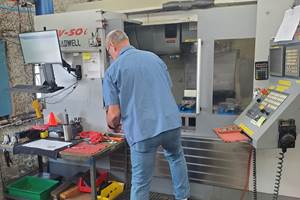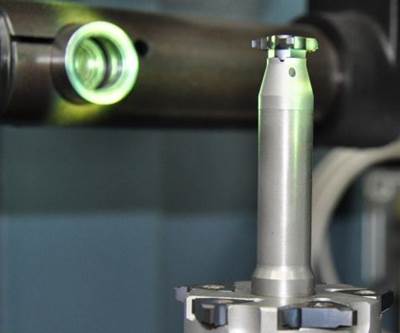What Makes a Top Shop Profitable?
The data from Gardner Intelligence's Top Shops survey can show us how technology and management tools relate to earnings and profit in machine shops. Register for this webinar to learn about some of the specific findings from the survey.
Share





Looking at the Top Shops survey, an individual might wonder what it is that makes a machine shop profitable. To explain how we determine the key drivers of revenue and profit in machine shops, Steve Kline from Gardner Intelligence, the research arm of 91ÊÓƵÍøÕ¾ÎÛ’s publisher Gardner Business Media, is to explain it in detail, but we can cover the broad strokes here.
Collecting Data on Manufacturing
Since 2012, more than 3,000 shops have responded to the Top Shops survey, providing us with a deep well of data. In addition to gathering numerical data, such as capacity utilization, lead time and profit margin, the survey gathers data on what machine tools, HR programs and improvement methodologies see use in the shop. With that raw data, we get to work making sense of it.
We take every piece of numerical data and use a statistical analysis to correlate it with gross revenue per machine, gross revenue per part and profit margin. To do this, we divide the data into the top and bottom quartiles — data groupings representing a quarter of the results — and look at the correlation of those quartiles with every piece of numerical data. And, we look at the percent of shops in the top and bottom quartiles of gross revenue and profit data to understand the correlation between the technologies, shop practices, and HR programs used with the revenue and profit data. With these data points all correlated, we can look at how technology and management tools relate to earnings and profit across all shops.
Analyzing Data to Identify Impact
Once we correlate the data, we come to an important question: What is relevant? To figure this out, we use a comparative analysis to look at how different technologies and practices impact the success of a shop.
There are two factors our analysts look for when it comes to determining the relevance of a process: the correlation and the significance. Correlation is easy to understand. Is the presence of a process or technology likely to coincide with increased profits? Obviously, this is a meaningful indicator of value added. However, it is equally important to look at the significance of a technology.
By comparing the top and bottom quartiles, we can see what technology is driving financial improvements

Steve Kline Jr., Chief Data Officer for Gardner Intelligence, speaks at the 2019 Top Shops Conference. According to Mr. Kline, the data from Top Shops can help us identify which technologies provide a significant impact on the profits of a machine shop. The data from Top Shops is available for purchase online.
According to Mr. Kline, significance can be measured by looking at the degree of correlation. For example, if we wanted to look at how machine type compares to gross sales per machine (GSM), we would look at the top quartile of GSM — the 25% of shops that average the largest dollar amount in sales per machine. We would then look at what percentage of those shops use each machine type, then compare that percent of shops in the bottom quartile — the 25% of shops with the lowest sales per machine — that use the same machine type.
Using this comparison method, we can say how much more likely shops that perform well in a given metric are to use a given technology. If the magnitude of the difference between use in the top and bottom quartiles is 20% or greater, then we consider it significant, meaning that the use of that technology likely drives improved financial performance.
Related Content
Same Headcount, Double the Sales: Successful Job Shop Automation
Doubling sales requires more than just robots. Pro Products’ staff works in tandem with robots, performing inspection and other value-added activities.
Read MoreJob Shops Can’t Do Everything, And That’s OK
Deciding to narrow down its jobs and customers was a turning point for 2023 Top Shops Business Strategies honoree Manda Machine that has led to improvements in the front office and on the shop floor.
Read MoreMachine Shop MBA
Making Chips and 91ÊÓƵÍøÕ¾ÎÛ are teaming up for a new podcast series called Machine Shop MBA—designed to help manufacturers measure their success against the industry’s best. Through the lens of the Top Shops benchmarking program, the series explores the KPIs that set high-performing shops apart, from machine utilization and first-pass yield to employee engagement and revenue per employee.
Read MoreCreating a Learning Culture at JD Machine
JD Machine, 2024’s Top Shops Honoree in Human Resources, embodies its “Education for Life” core value with a robust apprenticeship program and significant continuous improvement efforts.
Read MoreRead Next
Top Shops Share Their Top Technology
In this video taken at the 2019 Top Shops Conference, the year’s four Honors Program winners describe how they’ve each benefited from a new addition to their business.
Read MoreThe Tie Between Technology and People
Top Shops data analysis shows that investment in employees more directly correlates to profit margin than investment in equipment. Still, careful consideration of new technology matters.
Read MoreLast Chance! 2025 Top Shops Benchmarking Survey Still Open Through April 30
Don’t miss out! 91ÊÓƵÍøÕ¾ÎÛ's Top Shops Benchmarking Survey is still open — but not for long. This is your last chance to a receive free, customized benchmarking report that includes actionable feedback across several shopfloor and business metrics.
Read More






















